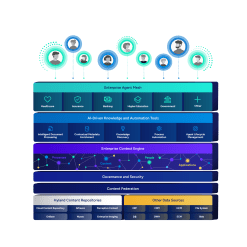Below are 10 critical requirements to include in your ECM replacement Request for Information (RFI)/Request for Proposal (RFP) to ensure successful migration, user adoption and long-term viability.
RFI/RFP Questions
1. Is the solution a platform or a product?
Why it matters: Using a platform for application development and delivery is how organizations will quickly launch new, innovative content-centric applications with the flexibility demanded by business. Customizing a product slows delivery, increases development costs, and reduces the ability to upgrade or add new features as new enhancements are released.
What to look for: A true platform with loosely coupled services that can be managed, upgraded, or replaced independently. Also, the ability to scale horizontally by adding nodes and segregating functionality between them.
2. Does the solution support federated access?
Why it matters: Change does not occur overnight. Organizations need an alternative to the disruptive nature of “rip-and-replace” methodologies. They need to access and manage information in place until it is convenient and cost effective to consolidate systems further.
What to look for: Connectors to legacy ECM and other information systems you use today, an open architecture, and a vendor mindset that doesn’t believe the answer to every question is a single repository.
3. Are content and data managed together?
Why it matters: Content can create other content, and content can create other data. Data can create other data; and data can create other content. But until recently content and data lived in very different systems. It is no longer a viable option to chase related information all across the organization.
What to look for: Data and content should be managed together within the same platform, combining all relevant pieces of information from across the enterprise. Pay specific attention to vendors who deliver this connected information capability via federation, as that does not require information to be migrated between systems.
4. Does the solution offer AI capabilities based on business-specific content and data?
Why it matters: As organizations seek to gain greater insight from their content and data, it quickly becomes clear that throwing bodies at the problem does not scale. Organizations need AI and machine learning to gain greater insight, delivered faster, through custom models trained for their own unique business.
What to look for: Vendors with experience at the leading edge of AI, who incorporate industry-leading AI technologies with vendor-specific IP to allow for user-friendly model training capabilities. Focus on vendors making use of business-specific data sets to train custom models, as these deliver a far superior and organization specific set of outcomes.
5. Can content and rich media be managed together?
Why it matters: Rich media is taking a more prominent role within organizations. Voice, photos, and video are now commonplace, due to the spread of smartphones. Enterprise Content Management and Digital Asset Management should be delivered together on a single platform, not two individual solutions.
What to look for: Capabilities to manage any type of content or data within the same solution.
Related articles
6. Does the solution offer low code development?
Why it matters: Low-code development provides business and technical users with a rapid means to deliver robust, dynamic applications to the enterprise. Organizations can now build apps, powerful enough for even the most complex business solutions, in days or weeks, not months or years.
What to look for: Vendors who provide a low-code solution that can be used to prototype, build, and deploy complete applications, not simply simple forms.
7. Are all of the architectural components independently scalable?
Why it matters: Legacy information systems were built as single, monolithic applications, delivered from one code base. Their static architecture also makes it impossible to scale individual parts of the solution; you can only scale the whole application. Modern systems are a collection of connected modular components, each of which can scale independently as required — delivering a much more cost- effective way of designing your information architecture to suit your individual needs.
What to look for: Independently, and horizontally, scalable component architectures that can be quickly ramped up to meet the performance demands of the business.
8. Is the architecture cloud-native?
Why it matters: As organizations demand faster delivery of business applications at lower costs, it is simply not practical to look to on-premises solutions for the answer. Cloud-native architectures reduce costs and meet fluctuating growth demands.
What to look for: Vendors with cloud-native architectures to allow your organization to be ready for the move to the cloud, even if your chosen deployment model is on-premises today.
9. Does the solution support continuous innovation?
Why it matters: The challenges of deploying software on major release cycles are well known. Continuous innovation means new features and functionality that are immediately available, keeping your organization current and minimizing upgrade headaches.
What to look for: A vendor committed to delivering robust, carefully managed, but yet entirely seamless software releases, whether you are in the cloud, hybrid or on-premises.
10. Does the vendor provide an API-First approach?
Why it matters: To deliver functionality quickly to fast-changing business needs, IT organizations need to manage small, autonomous, versioned and scalable units of work that can be quickly stitched together into larger applications – but tested in isolation with minimal impact on the rest of the system.
What to look for: Vendors who expose all of their functionality via API, especially - specifically those who are making use of the API-first mentality, to ensure that all new functionality is instantly available via the API.










